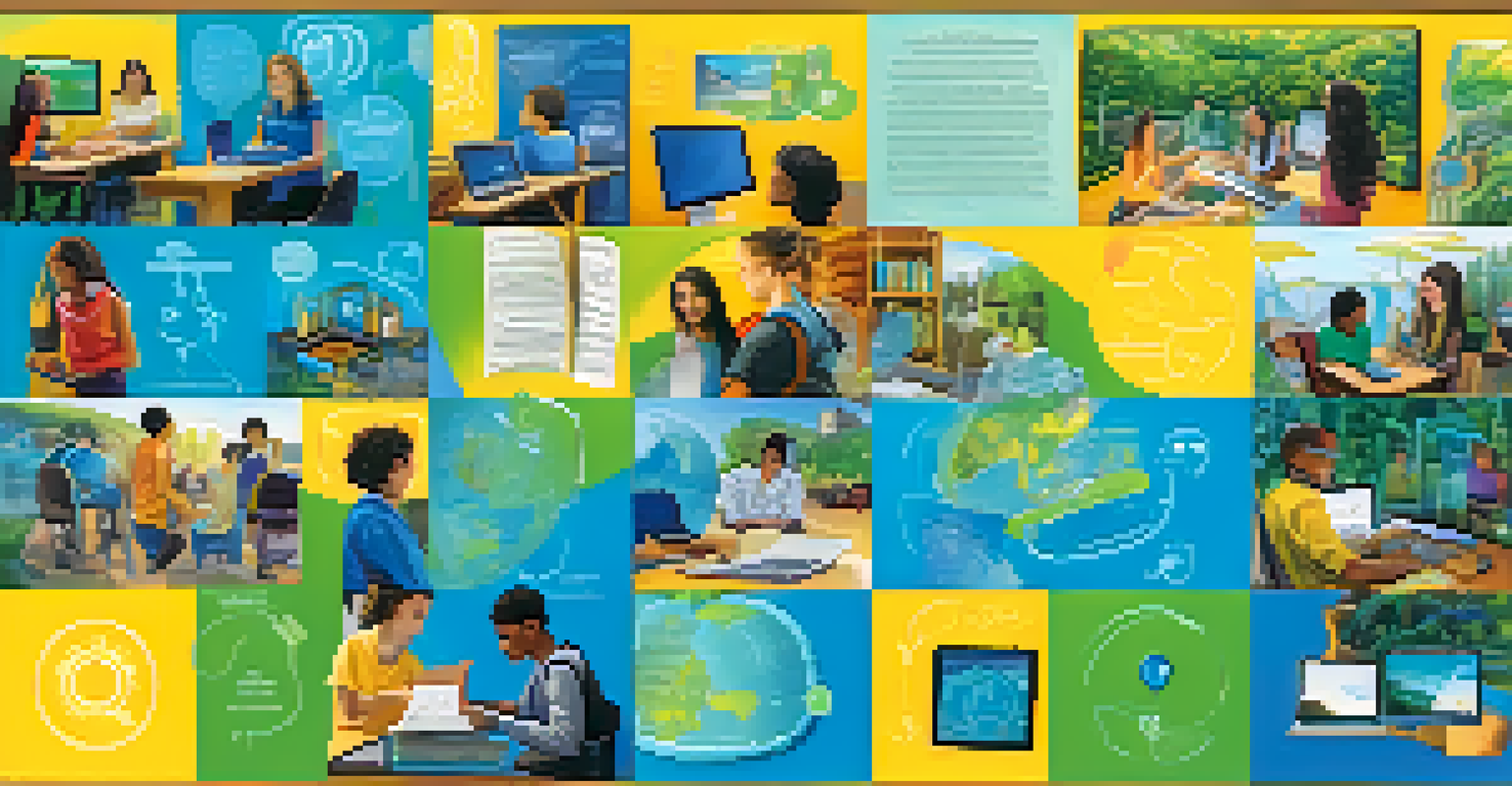The Benefits of Peer Learning in Virtual Classrooms

Understanding Peer Learning in Virtual Classrooms
Peer learning refers to the process where students learn from and with each other, often facilitating deeper understanding. In virtual classrooms, this approach can enhance engagement, as students share insights and perspectives. It creates a collaborative environment, which is crucial in a setting that can sometimes feel isolating.
The greatest gift of the educational system is that it enables you to think critically and creatively, to solve problems and to communicate effectively with others.
By working together, students can tackle difficult concepts, breaking down barriers to understanding. For instance, a student struggling with a math problem may find clarity after discussing it with a peer who grasps the concept. This type of interaction not only fosters learning but also builds relationships among classmates.
In this digital age, embracing peer learning can transform the traditional educational experience. It empowers students to take charge of their learning journey, promoting accountability and motivation as they help each other succeed.
Enhancing Communication Skills Through Collaboration
One of the standout benefits of peer learning is the improvement in communication skills. Engaging with peers in discussions and group projects encourages students to articulate their thoughts clearly. This practice is invaluable, especially in a virtual setting where effective communication can sometimes be challenging.

For example, working on a group presentation requires students to express their ideas and listen to others. This back-and-forth not only sharpens their verbal skills but also boosts their confidence in sharing opinions. As students learn to navigate online discussions, they develop a more nuanced understanding of how to communicate effectively in various contexts.
Peer Learning Boosts Engagement
Collaborative learning enhances student engagement and motivation by fostering accountability among peers.
In essence, peer learning nurtures essential life skills that go beyond academics. As students collaborate, they learn the art of negotiation, persuasion, and empathy—skills that are vital in both personal and professional realms.
Fostering a Sense of Community and Belonging
In a virtual classroom, it can be easy for students to feel disconnected. Peer learning plays a crucial role in building a sense of community, creating bonds among students. When learners collaborate, they develop relationships that foster a supportive environment, which is key to academic success.
Alone we can do so little; together we can do so much.
Consider a scenario where students form study groups for a challenging course. These groups not only provide academic support but also create friendships that enhance the overall learning experience. Feeling connected to peers can motivate students to participate more actively and stay engaged throughout the course.
Ultimately, this sense of belonging can reduce feelings of isolation often associated with online learning. As students share their struggles and triumphs, they learn that they are not alone in their educational journey, creating a more enriching experience.
Encouraging Diverse Perspectives and Ideas
Peer learning opens the door to a plethora of diverse perspectives. Each student brings their unique background and experiences, enriching discussions with varied viewpoints. This diversity can lead to more comprehensive understanding of topics, as students are exposed to ideas they may not have considered before.
For instance, when working on a project, students from different cultural backgrounds can present unique solutions based on their experiences. This exchange of ideas not only broadens horizons but also fosters critical thinking, as students learn to evaluate and appreciate different perspectives.
Diverse Perspectives Enrich Learning
Engaging with classmates from various backgrounds exposes students to different viewpoints, enhancing critical thinking.
In a world that increasingly values diversity and inclusion, peer learning in virtual classrooms prepares students to navigate these complexities. It encourages openness and respect, essential qualities in both academic and real-world interactions.
Boosting Motivation and Engagement in Learning
Motivation can sometimes wane in a virtual learning environment, but peer learning can reignite that spark. When students collaborate, they often feel a renewed sense of purpose and accountability to one another. This shared responsibility can lead to more consistent participation and enthusiasm for learning.
For example, when students work together on assignments, they are more likely to stay committed to their tasks, knowing their peers depend on them. This dynamic creates an engaging learning environment, making the process enjoyable rather than a chore.
Furthermore, the encouragement from peers can boost confidence, leading students to take on challenges they might otherwise shy away from. In this way, peer learning not only enhances academic performance but also nurtures a positive attitude towards education.
Promoting Critical Thinking and Problem-Solving Skills
Engaging with peers often involves tackling complex problems together, which can significantly enhance critical thinking skills. By discussing various approaches to a problem, students learn to analyze situations from multiple angles. This collaborative brainstorming not only sharpens their reasoning abilities but also encourages innovative thinking.
For instance, when students work together to solve a case study, they must evaluate information, consider different viewpoints, and come up with a collective solution. This process pushes them to think critically and develop strategies for effective problem-solving.
Community Reduces Isolation
Peer learning fosters a sense of community in virtual classrooms, helping students feel connected and supported.
Incorporating peer learning in virtual classrooms equips students with essential skills that are highly valued in today’s workforce. The ability to think critically and solve problems collaboratively prepares them for real-world challenges.
Facilitating Personalized Learning Experiences
Peer learning allows for a more personalized approach to education. Students can share their strengths and weaknesses with one another, tailoring their learning experiences accordingly. This flexibility fosters an environment where learners can progress at their own pace, rather than feeling rushed to keep up with a standard curriculum.
For example, a student who excels in writing can assist peers struggling with essays, while gaining insights into areas where they may need improvement. This reciprocal teaching not only reinforces knowledge but also builds confidence in both the tutor and the learner.

Overall, personalized learning through peer collaboration acknowledges that each student has unique needs and styles. This approach not only enhances understanding but also creates a more inclusive educational experience.
Conclusion: Embracing the Future of Learning Together
As we embrace the digital age, the benefits of peer learning in virtual classrooms become increasingly evident. From enhancing communication skills to fostering a sense of community, this collaborative approach enriches the educational experience. It prepares students for not just academic success but also for the complexities of the modern world.
By integrating peer learning into virtual classrooms, educators can create dynamic and engaging environments that cater to diverse learning styles. This strategy not only enhances individual learning but also cultivates a culture of cooperation and respect among students.
In conclusion, as we move forward in education, let us prioritize peer learning as a fundamental component. Together, we can unlock the full potential of online education, transforming challenges into opportunities for growth and connection.